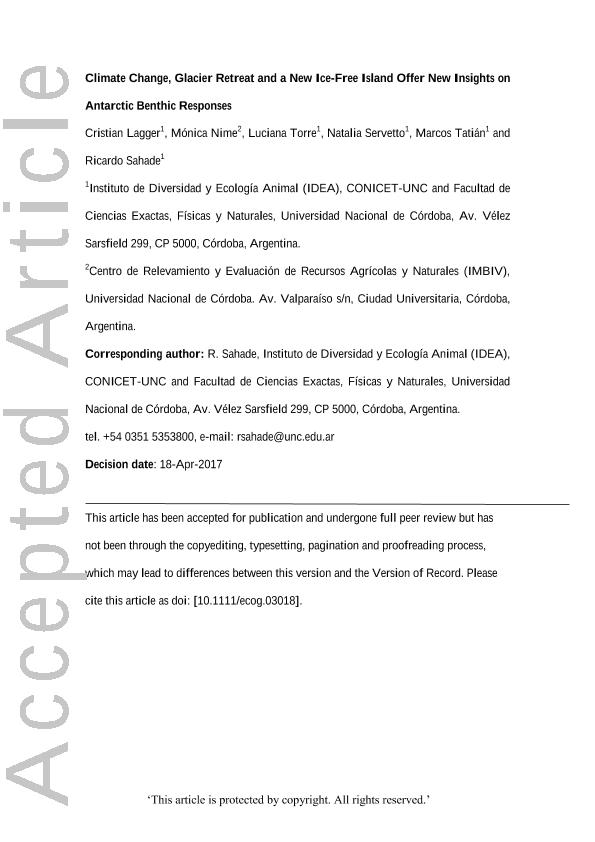Mostrar el registro sencillo del ítem
dc.contributor.author
Lagger, Cristian Fabian

dc.contributor.author
Nime, Mónica Fernanda

dc.contributor.author
Torre, Luciana

dc.contributor.author
Servetto, Natalia

dc.contributor.author
Tatian, Marcos

dc.contributor.author
Sahade, Ricardo Jose

dc.date.available
2018-08-24T14:05:31Z
dc.date.issued
2018-04
dc.identifier.citation
Lagger, Cristian Fabian; Nime, Mónica Fernanda; Torre, Luciana; Servetto, Natalia; Tatian, Marcos; et al.; Climate change, glacier retreat and a new ice-free island offer new insights on Antarctic benthic responses; Wiley Blackwell Publishing, Inc; Ecography; 41; 4; 4-2018; 579-591
dc.identifier.issn
0906-7590
dc.identifier.uri
http://hdl.handle.net/11336/56935
dc.description.abstract
The Antarctic Peninsula is among the places on Earth that registered major warming in the last 60 yr. Massive ice losses, represented by glacier retreat, ice-shelf collapses and sea-ice reduction are among the main impacts of this regional warming. The loss of sea-bed ice coverage, on the one hand has been affecting benthic assemblages, but on the other it is opening up new areas for benthic colonisation. Potter Cove (South Shetland Islands) offered the opportunity of assessing both processes. We recently reported a sudden shift of benthic assemblages related to increased sedimentation rates caused by glacier retreat. This glacier retreat also uncovered a new island that presents a natural experiment to study Antarctic benthic colonisation and succession. We sampled the new island by photo-transects taken up to 30 m depth. Here, we report an unexpected benthic assemblage characterised by high species richness, diversity and structural complexity with a well-developed three-dimensional structure and epibiotic relationships. Filter feeders comprised the largest trophic group at all depths, mainly ascidians, sponges and bryozoans. Densities were also surprising, recording only six ascidian species with a mean of ∼310 ind. m–2. These values are at least an order of magnitude higher than previous Antarctic reports on early colonisation. This finding challenges the extended idea of a slow and continuous recruitment in Antarctica. However, it also opens the question of whether these complex assemblages could have been present under the glacier in ice-free refuges that are now exposed to open sea conditions. Under the current scenario of climate change, these results acquire high relevance as they suggest a two-fold effect of the Antarctic Peninsula warming: the environmental shifts that threaten coastal ecosystems, and also the opening up of new areas for colonisation that may occur at a previously unimagined speed.
dc.format
application/pdf
dc.language.iso
eng
dc.publisher
Wiley Blackwell Publishing, Inc

dc.rights
info:eu-repo/semantics/openAccess
dc.rights.uri
https://creativecommons.org/licenses/by-nc-sa/2.5/ar/
dc.subject
Antarctica
dc.subject
New Ide-Free Areas
dc.subject
Benthos
dc.subject.classification
Otras Ciencias Biológicas

dc.subject.classification
Ciencias Biológicas

dc.subject.classification
CIENCIAS NATURALES Y EXACTAS

dc.title
Climate change, glacier retreat and a new ice-free island offer new insights on Antarctic benthic responses
dc.type
info:eu-repo/semantics/article
dc.type
info:ar-repo/semantics/artículo
dc.type
info:eu-repo/semantics/publishedVersion
dc.date.updated
2018-08-17T14:31:13Z
dc.identifier.eissn
1600-0587
dc.journal.volume
41
dc.journal.number
4
dc.journal.pagination
579-591
dc.journal.pais
Reino Unido

dc.journal.ciudad
Londres
dc.description.fil
Fil: Lagger, Cristian Fabian. Consejo Nacional de Investigaciones Científicas y Técnicas. Centro Científico Tecnológico Conicet - Córdoba. Instituto de Diversidad y Ecología Animal. Universidad Nacional de Córdoba. Facultad de Ciencias Exactas Físicas y Naturales. Instituto de Diversidad y Ecología Animal; Argentina
dc.description.fil
Fil: Nime, Mónica Fernanda. Consejo Nacional de Investigaciones Científicas y Técnicas. Centro Científico Tecnológico Córdoba. Instituto Multidisciplinar de Biología Vegetal (P). Grupo Vinculado Centro de Relevamiento y Evaluación de Recursos Agrícolas y Naturales; Argentina
dc.description.fil
Fil: Torre, Luciana. Consejo Nacional de Investigaciones Científicas y Técnicas. Centro Científico Tecnológico Conicet - Córdoba. Instituto de Diversidad y Ecología Animal. Universidad Nacional de Córdoba. Facultad de Ciencias Exactas Físicas y Naturales. Instituto de Diversidad y Ecología Animal; Argentina
dc.description.fil
Fil: Servetto, Natalia. Consejo Nacional de Investigaciones Científicas y Técnicas. Centro Científico Tecnológico Conicet - Córdoba. Instituto de Diversidad y Ecología Animal. Universidad Nacional de Córdoba. Facultad de Ciencias Exactas Físicas y Naturales. Instituto de Diversidad y Ecología Animal; Argentina
dc.description.fil
Fil: Tatian, Marcos. Consejo Nacional de Investigaciones Científicas y Técnicas. Centro Científico Tecnológico Conicet - Córdoba. Instituto de Diversidad y Ecología Animal. Universidad Nacional de Córdoba. Facultad de Ciencias Exactas Físicas y Naturales. Instituto de Diversidad y Ecología Animal; Argentina
dc.description.fil
Fil: Sahade, Ricardo Jose. Consejo Nacional de Investigaciones Científicas y Técnicas. Centro Científico Tecnológico Conicet - Córdoba. Instituto de Diversidad y Ecología Animal. Universidad Nacional de Córdoba. Facultad de Ciencias Exactas Físicas y Naturales. Instituto de Diversidad y Ecología Animal; Argentina
dc.journal.title
Ecography

dc.relation.alternativeid
info:eu-repo/semantics/altIdentifier/url/http://doi.wiley.com/10.1111/ecog.03018
dc.relation.alternativeid
info:eu-repo/semantics/altIdentifier/doi/http://dx.doi.org/10.1111/ecog.03018
Archivos asociados
